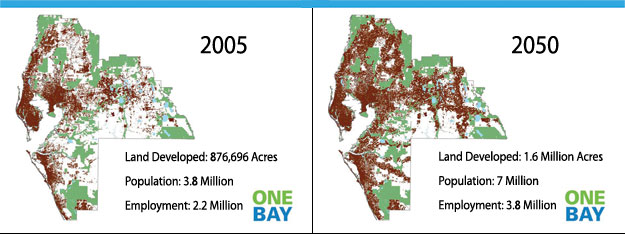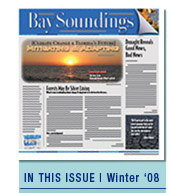 |
||||||||
Reality Check Goes “On the Road”
Building upon the visions detailed by 300 leaders from across the region at Reality Check Tampa Bay last Spring, organizers took the planning exercise on the road to elicit input from residents in each of the seven counties in the Tampa Bay Partnership.
Like the first event, participants used Legos and colored ribbons to create a vision of the future, allocating anticipated population growth, work centers and transportation systems. As was expected, residents in each county – a total of 650 in the eight local events – had a slightly different slant to their vision of how the region should look in 2050, when the regional population increases by 84% to a total of 7 million people.
In Hillsborough County, for instance, traffic congestion was rated as a top concern by 53% of participants, while only 25% of Hernando County residents only ranked it as a top priority. On the other hand, 35% of Hernando residents ranked increased water and groundwater pollution as top concerns, while only 7% of Hillsborough participants named it as a priority.

Participants in the “road shows” also had the opportunity to vote on their top two choices on guiding principles for development over the next 50 years. Grassroots participants differed in several ways from the original 300 leaders:
- Promote quality communities to create a sense of place by clustering higher density mixed-use development around transportation corridors (29%, Spring 2007 vs. 26% last Fall)
- Maximize mobility using multi-modal transportation (24% vs. 16%)
- Preserve natural systems, emphasizing connectivity and sustainable water supplies (20% and 20%)
- Balance jobs and housing for affordable quality of life (12% vs. 15%)
- Attract higher paying jobs – strengthen economic development (12% vs. 18%)
- Preserve farmland and sustain the role of agriculture (3% vs. 5%)
Other results of the multi-county outreach indicate that: - 43% of participants did not believe enough jobs were planned for their county
- Less than 9% of residents agreed that new residents should be housed in currently undeveloped parts of the region
- More than 90% of people agree or strongly agree that most future development should occur in mixed-use town centers and along corridors
- More than 75% said blighted areas should be redeveloped before using open space for new development
- More than 90% believe that high-density neighborhoods are a good choice, if they are well-designed and provide open space
- A minority of participants believe that transportation should be mostly roads (3%) or mostly transit (9%) with 35% calling for a balance between roads and transit
- Across the region, the top environmental concern is loss of open space and wetlands.
Additionally, more than 56% of respondents said they were “very concerned” about having an adequate supply of drinking water to serve increased populations.
The next phase of the multi-year visioning effort includes an extensive public outreach campaign designed to create broader awareness and involve more citizens in sharing their vision for Tampa Bay’s future. At the same time, One Bay will be working closely with local governments, community groups and other stakeholders to build consensus and ensure adoption of the regional vision.
For more information, including detailed county-by-county breakdowns on results or to become involved, visit
www.myonebay.com.
Back to Top

